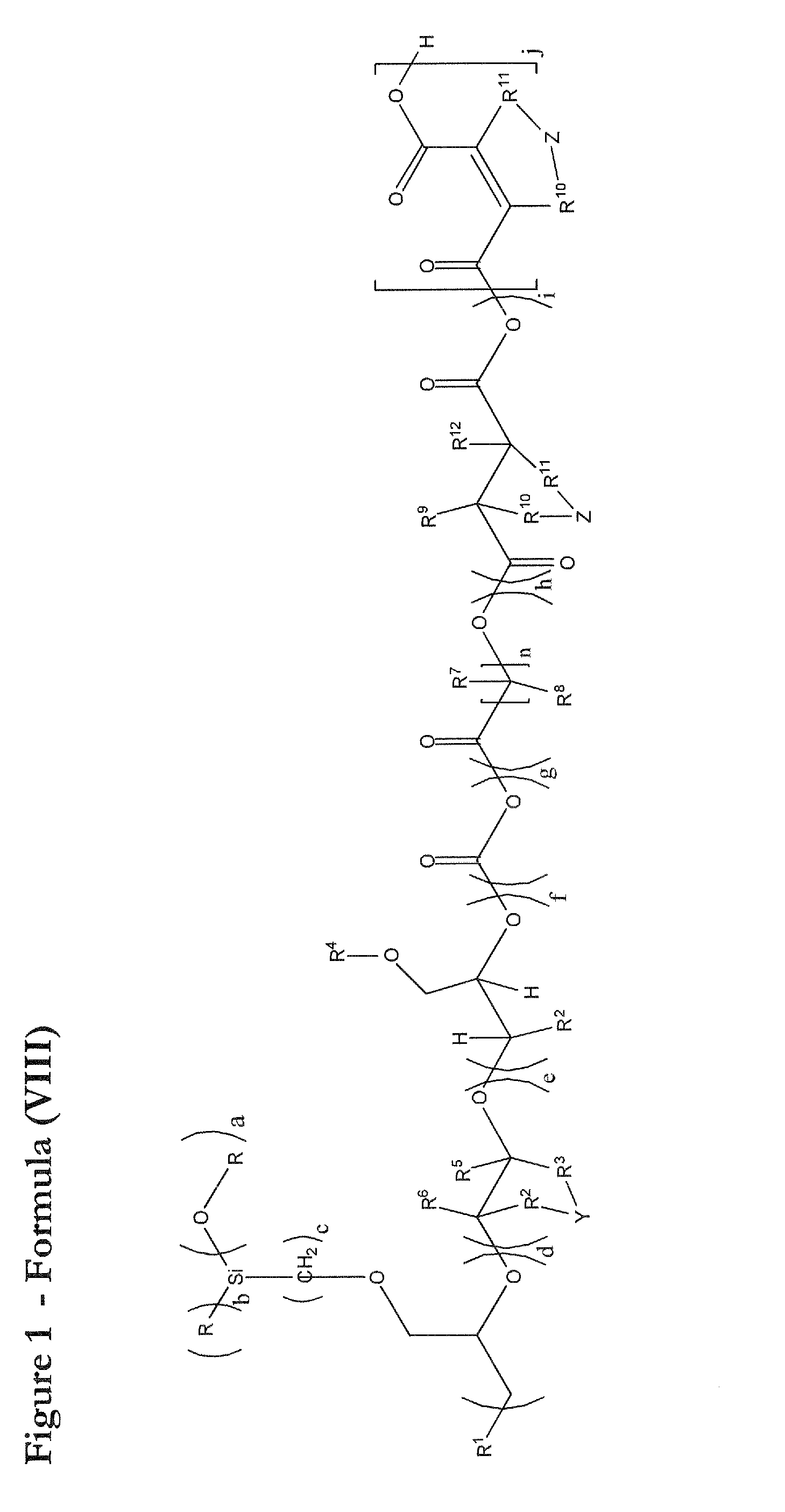Novel polyether alcohols bearing alkoxysilyl groups by alkoxylation of epoxy-functional alkoxysilances over double metal cyanide (DMC) catalysts, and processes for preparation thereof
a technology of polyether alcohols and alkoxysilanes, which is applied in the field of polyether alcohols bearing alkoxysilyl groups by alkoxylation of epoxyfunctional alkoxysilanes over double metal cyanide (dmc) catalysts, can solve the problems of polyethers with a relatively wide molar mass distribution and unsaturated by-products, inadequate regioselectivity, and inability to control in an obvious way
- Summary
- Abstract
- Description
- Claims
- Application Information
AI Technical Summary
Benefits of technology
Problems solved by technology
Method used
Image
Examples
working examples
[0122]In the examples adduced below, the present invention is described by way of example, without the invention, whose scope of application is evident from the entire description and the claims, being interpreted as restricted to the embodiments cited in the examples.
[0123]Preparation of polyether alcohols bearing alkoxysilyl groups by the process according to the invention with the aid of DMC catalysts. OH numbers were determined by the cold acetylation method based on the analysis method C-V 17A (98) of the Deutsche Gesellschaft für Fettwissenschaft (DGF); (German Society for Fat Science). The mean molar masses were determined by calculation from the OH numbers thus determined. The epoxide oxygen content of the end products was determined in the presence of conc. HCl by the principle of back-titration with sodium hydroxide solution.
example 1
[0124]A 3 litre autoclave is initially charged with 130.2 g of polypropylene glycol monobutyl ether (mean molar mass 520 g / mol) and 0.10 g of zinc hexacyanocobaltate DMC catalyst under nitrogen and heated to 130° C. with stirring. The reactor is evacuated down to an internal pressure of 30 mbar in order to remove any volatile constituents present by distillation. To activate the DMC catalyst, a portion of 58.0 g of propylene oxide is fed in. After 15 min and startup of the reaction (decline in internal reactor pressure), simultaneously and from two different reservoir vessels, 556.0 g of 3-glycidyloxypropyltriethoxysilane (DYNASYLAN® GLYEO) and 1363.0 g of propylene oxide are metered in continuously and with cooling at 130° C. and max. internal reactor pressure 0.9 bar absolute within 30 min. The 90-minute postreaction at 130-150° C. is followed by the degassing stage. In this stage, volatile fractions such as residual propylene oxide are distilled off under reduced pressure. The fi...
example 2
[0126]A 3 litre autoclave is initially charged with 200.0 g of polypropylene glycol monobutyl ether (mean molar mass 750 g / mol) and 0.015 g of zinc hexacyanocobaltate DMC catalyst under nitrogen. The mixture is heated to 130° C., then freed of any volatile constituents at 30 mbar. To activate the DMC catalyst, a portion of 225.0 g of 3-glycidyloxypropyltriethoxysilane (DYNASYLAN® GLYEO) is fed in. After the reaction has started up (slight exothermicity) and DYNASYLAN® GLYEO has been depleted, first 59.1 g of ethylene oxide within 10 min and finally a further 225.0 g of 3-glycidyloxypropyltriethoxysilane (DYNASYLAN® GLYEO) within 20 min are metered in with cooling at 130° C. and max. internal reactor pressure 0.8 bar absolute. The 90-minute postreaction at 130-150° C. is followed by the degassing stage in order to remove volatile fractions.
[0127]The resulting polyetherol is formed from DYNASYLAN® GLYEO and ethylene oxide blocks, is of low viscosity, contains an average per molecule o...
PUM
| Property | Measurement | Unit |
|---|---|---|
| molecular weight | aaaaa | aaaaa |
| alkaline | aaaaa | aaaaa |
| molar mass distribution | aaaaa | aaaaa |
Abstract
Description
Claims
Application Information
 Login to View More
Login to View More - R&D
- Intellectual Property
- Life Sciences
- Materials
- Tech Scout
- Unparalleled Data Quality
- Higher Quality Content
- 60% Fewer Hallucinations
Browse by: Latest US Patents, China's latest patents, Technical Efficacy Thesaurus, Application Domain, Technology Topic, Popular Technical Reports.
© 2025 PatSnap. All rights reserved.Legal|Privacy policy|Modern Slavery Act Transparency Statement|Sitemap|About US| Contact US: help@patsnap.com



